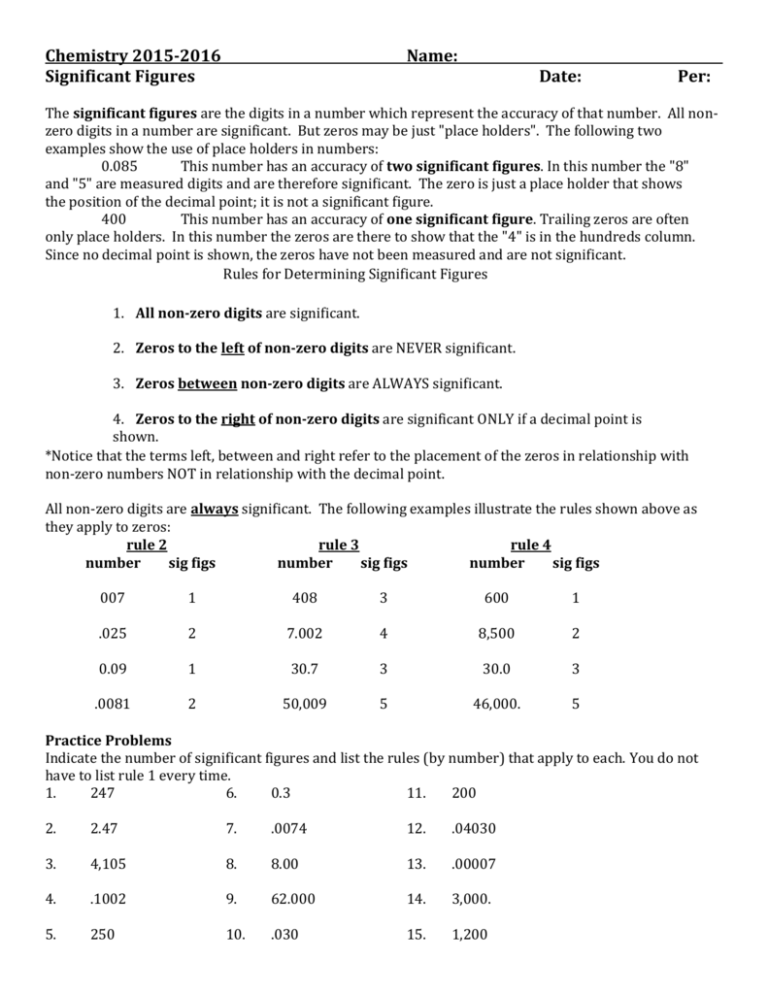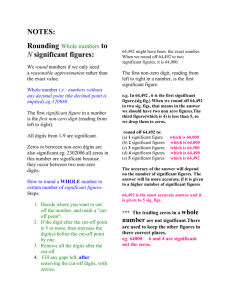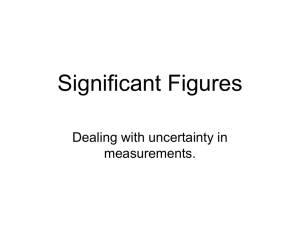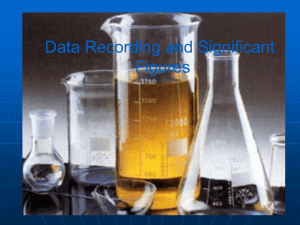Significant Figures Chemistry Worksheet
advertisement

Chemistry 2015-2016 Significant Figures Name: Date: Per: The significant figures are the digits in a number which represent the accuracy of that number. All nonzero digits in a number are significant. But zeros may be just "place holders". The following two examples show the use of place holders in numbers: 0.085 This number has an accuracy of two significant figures. In this number the "8" and "5" are measured digits and are therefore significant. The zero is just a place holder that shows the position of the decimal point; it is not a significant figure. 400 This number has an accuracy of one significant figure. Trailing zeros are often only place holders. In this number the zeros are there to show that the "4" is in the hundreds column. Since no decimal point is shown, the zeros have not been measured and are not significant. Rules for Determining Significant Figures 1. All non-zero digits are significant. 2. Zeros to the left of non-zero digits are NEVER significant. 3. Zeros between non-zero digits are ALWAYS significant. 4. Zeros to the right of non-zero digits are significant ONLY if a decimal point is shown. *Notice that the terms left, between and right refer to the placement of the zeros in relationship with non-zero numbers NOT in relationship with the decimal point. All non-zero digits are always significant. The following examples illustrate the rules shown above as they apply to zeros: rule 2 rule 3 rule 4 number sig figs number sig figs number sig figs 007 1 408 3 600 1 .025 2 7.002 4 8,500 2 0.09 1 30.7 3 30.0 3 .0081 2 50,009 5 46,000. 5 Practice Problems Indicate the number of significant figures and list the rules (by number) that apply to each. You do not have to list rule 1 every time. 1. 247 6. 0.3 11. 200 2. 2.47 7. .0074 12. .04030 3. 4,105 8. 8.00 13. .00007 4. .1002 9. 62.000 14. 3,000. 5. 250 10. .030 15. 1,200 Chemistry 2015-2016 Significant Figure Math Name: Date: Per: Addition and Subtraction: When doing calculations involving measurements, the answer can only be as accurate as the least accurate measurement made. Rule: The answer must be rounded off to the same place value as the least precise measurement used in the calculation. Sample Problem Subtract: 246.58-87.3 Solution Calculator answer: 159.28 246.58 is significant to the hundredths place. 87.3 is only significant to the tenths place. This means that our answer must be reported to the tenths place. Answer: 159.3 Sample Problem Add: 4,300 + 928.6 Solution Calculator answer: 5,228.6 4300 is significant to the 3 (hundreds place). 928.6 is significant to the 6 (tenths place). Our answer can only be reported as far as the hundreds place Answer: 5,200 Problems do the addition or subtraction indicated, and round your answer to the correct precision. 1) 9.4 + 1.47 4) 2) 72.9 - 4.883 5) 3) 3.6 + 8 6) 300 + 260 19.868 - 5 4,700 - 520 7) 8) 9) 1.75 105.0 42.02 + .5483 200. + 1.4 18.0 - 6.18 10) 9.3046 .23 400 + 62.4 11) .0514 + .07 12) 37 - 4.29 Rounding: When rounding off numbers, if what you drop off is greater than or equal to five, round up; if what you drop off is less than five, leave what remains alone. Example: 150 rounded to the hundreds place is 200, whereas 149 rounded to the hundreds place is 100. Multiplication and Division: When multiplying of dividing numbers you must count the number of significant figures in each number and round off the answer to the same number of significant figures as the least accurate number. Rule: The answer must be rounded off to the same number of significant figures as the least accurate measurement used in the calculation. Sample Problem: Multiply: (34.0)*(.0921084) Solution Count significant figures: 3 6 Calculator answer: 3.1316856 Our least significant input only has 3 significant digits; therefore our answer should only have 3 significant digits. Rounded to the correct accuracy: 3.13 Sample Problem: Divide: Solution Count significant figures: 534.168 0.07 6 1 Calculator answer: 76.30971 Our least significant input only has 1 significant digit; therefore our answer should only have 1 significant digit. Rounded to the correct accuracy: 80 Problems: Label each number as to how many significant figures it contains. Write down your calculator answer and then the answer rounded to the correct accuracy. 1. (16.00) (.617289) 5. (560) (.0031842) 2. 65.431 .003 6. (0.050002) (406) 7. 30.5 .050817 8. 128 16 3. (.030040) (78.00000) 4. .8000 .20 Chemistry 2015-2016 Significant Figure Math Practice Name: Date: Per: Directions: Show both your calculator answer and the final answer (rounded correctly). When Adding or Subtracting When Multiplying or Dividing The answer must be rounded off to the same The answer must be rounded off to the column (ones, tenths, hundredths, etc.) as the same number of significant figures as the least precise measurement used in the least accurate measurement used in the calculation. calculation. 1) 121.6 1.123 + 31.6 9) 2) 13.421 11.7 10) 342 .007 3) 1511 .00712 11) (1221) (605) 4) 93.612 34.7113 + 15.16 12) 13.61 - 1.2 5) (1359) (2.5) 13) 16.217 - 15.74 6) 7.6 113.2 14) (256.1) (135.7) (112) (2) 7) (2.3) (.00211) 46.1 15) (7148.571) (.0700) 8) 60.0 - 58.007 16) 1211.21 12.42 + 1 4.0000 + 6.00 4









